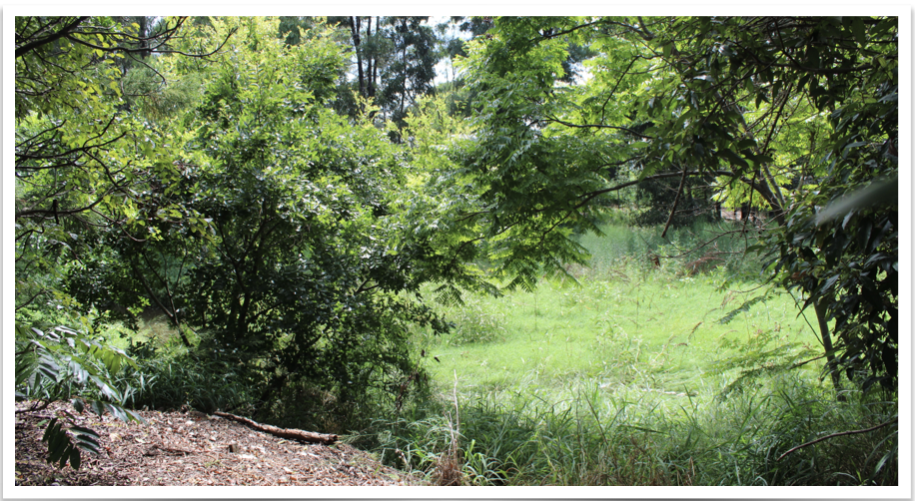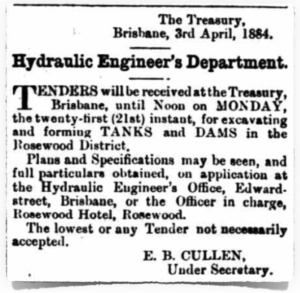
Present day view of the site of Mason’s Dam.
Rosewood History
Mason’s Dam
On 27th February 1884, Mr. John Baillie Henderson, a Government Hydraulic Engineer and Mr. Rand, a Geologist, visited Rosewood. They came by the morning train, mounted horses provided for them by William Mathew, and accompanied David Pfrunder (Chairman of Divisional Board) through the scrub. They were on a mission to examine the different strata of soil in the district and select suitable sites for dams. A spot was chosen half a mile from the Gate in the gully at Mason’s bridge.
A test hole was dug by Mr Boughen and if the soil proved to be satisfactory Richard Mason had indicated he was prepared to sell a couple of acres of his land at a reasonable price for the construction of a dam.
 In March 1884, John Henderson wrote a letter to the Walloon Divisional Board stating that the site selected on the south-west corner of Mason’s property was the most suitable for the construction of a dam. The Board agreed to the recommendation so a portion of Richard Mason’s land was resumed by the Government for this purpose. They also agreed to a request that the excavated material should be placed along the east side of the road between the bridge and Freeman’s house. Tenders for a ganger to do the work were sought. The dam’s capacity was expected to be about 1400 cubic yards. (One cubic yard = 764.55 litres)
In March 1884, John Henderson wrote a letter to the Walloon Divisional Board stating that the site selected on the south-west corner of Mason’s property was the most suitable for the construction of a dam. The Board agreed to the recommendation so a portion of Richard Mason’s land was resumed by the Government for this purpose. They also agreed to a request that the excavated material should be placed along the east side of the road between the bridge and Freeman’s house. Tenders for a ganger to do the work were sought. The dam’s capacity was expected to be about 1400 cubic yards. (One cubic yard = 764.55 litres)
On the 12th May, Mr. McKinnon, also from the Hydraulic Engineer’s Department, visited Rosewood and met with a contractor to layout the plan for the dam at Mason’s Bridge. The contractor was ready to start the construction immediately, which he did.
On the 31st a sad accident occurred at the site. The men were undermining a bank of earth about 14ft high and 30ft long (4.26m x 9.1m) when part of it suddenly gave way and many tons of the loose earth fell on two of the men. One man, Samuel Strong, aged about 23, was completely buried and died just as they uncovered his head. Samuel and his family were from Wicklow, Ireland and had settled in Gatton. They’d only been in the country for almost nine months. The other man was Henry Beavis, a son of Martin and Zillah Beavis. He tried to escape but he was thrown face down with most of his body being trapped under the rubble. Henry’s two brothers, who were also working on the site, quickly pulled him out. Henry was badly bruised, especially about the legs but he survived. The fall of earth was so great that it struck a horse and dray some 20ft away. The horse was knocked down and the dray was smashed.
By February the next year (1885) the dam was filling up with silt. This was caused by 2 issues. The downhill flow of water from the area above the dam and the treading of horses and cattle around the dam.
In 1886 the Divisional Board arranged the cutting of a waterway to carry water into Mason’s Dam.
There were always matters that needed to be attended to with the dam and it was required regular attention.
In early April 1890, Mr. Henderson was back and he was accompanied by Mr Graham the local policeman. Together they inspected the large Government dam and reported that, as a result of by-wash, the water had washed across the road causing severe damage and the dam was in danger of spilling. The local authority was informed that the structure was to be repaired immediately so it would be in a safe condition. The repairs were carried out at the expense of the Hydraulic Engineer’s Department and the Walloon Board was sent a request for payment in July. Payment was granted, but was then referred to the brand new divisional board of Rosewood.
There was a fence around the dam and it was constantly in need of repair for various reasons. The fence allowed people to access the dam in order to have a drink or to water their horses and cattle, and occasionally, to have a risky swim. Richard Mason offered to repair the fence but the local authorities felt that it wasn’t their responsibility because it was a Government dam. Reason prevailed over the years and there were occasions that the council paid for repairs for the safety of the community.
One purpose the dam was used for rightly caused outrage in the community.
A great sensation was caused here on Sunday morning last by a prominent man in the township drowning two of his dogs in the Government dam. The people are naturally very indignant at such inhuman conduct, and expressed their opinions very freely. As the affair was witnessed by some boys, there should be no difficulty in making an example of the offender. When the matter came to the knowledge of the Divisional Board Clerk, he very promptly employed a man to remove the animals. At the present time only a few people use the dam, but, should the present weather last, a good many would be obliged to draw on it. [1]
Then in February 1893 there was a different concern.
While in Rosewood on Saturday last, a representative of this journal, at the invitation of Mr. D. Pfrunder, paid a casual visit to the dam, known as Mason’s Dam, on the outskirts of the township. It is stated that the place has long been considered an eyesore and a source of nuisance to the township.
The dam was constructed in the centre of a natural watercourse, and, as the flow of water from the gullies above is somewhat great during rainy weather, this has consequently caused the water to break over the banks of the dam. Therefore, whenever rain came it received injury, and part of the by-wash has gradually been forced away. The state of the dam was bad enough before the late floods, but, as a very great volume of water then came down from the higher ground beyond, far greater damage has now resulted. Where the by-wash originally was, a large channel now exists, a great quantity of material having been washed away; while the water, having run over the road from time to time at the opposite corner, has caused this hole to extend back to a culvert, leaving the latter in a rather dangerous position.
During the flood, some anxiety was shown by the residents who live in close proximity to the place lest the whole of the embankment should give way and let the water contained in the dam run down towards their houses, some of which must then have been flooded. There is no immediate danger at present in this latter direction, but, should another flood take place before the dam has been attended to in some way, it will doubtless be irreparably destroyed, besides causing damage to other property.
It is said that some £80 was expended in temporarily repairing it, but this outlay has now proved of little avail. Some contend that the dam should never have been constructed in its present position, but we hear, on the best of authority, that the authorities’ instructions were to have it located on a main road, so that farmers could water their horses when coming into town, and also as near as possible to the railway station, in order to allow of water being procured for the locomotives and other purposes with as little trouble as possible.
The matter was referred to by Mr. J. Lane at the meeting of the Rosewood Board on Saturday, and it was agreed to write to Mr. Henderson, informing him of the state of the dam. The dam sadly needs attention, and we hope that it will be repaired as soon as possible. [2]
Still some apprehension was felt by residents in the neighbourhood that it may burst and overflow their houses.
Water spillage from this natural water-course (known as Mason’s Gully) continued to affect the town causing sanitary problems. Part of the problem was the rubbish which had built up in the creek bed and obstructed the flow. In 1903, the Commissioner for Public Health requested that the natural course of the water be “straightened from the dam down to where the culvert passes beneath the main street near the blacksmith’s shop” (Elder’s). It was also necessary to clean out the obstructions from the creek bed and clean up the rubbish which was scattered over back yards and vacant allotments. All the cesspits in the shire had to be emptied and the contents buried. As there were no systematic services for night soil and garbage collection, the Commissioner instructed the Council to take steps to instigate them.
Late in 1908 serious chatter began about a designing a Drainage Scheme for the town. It was finally completed at the end of 1912.
© Jane Schy, 2024
[1] Queensland Times, Ipswich Herald and General Advertiser, Saturday, 28 November 1891, page 5
[2] Queensland Times, Tuesday, 28 February 1893, page 4
